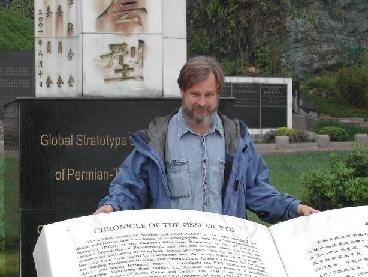The end of the Permian period 252 million years ago saw the greatest mass extinction in the geological record. Many theories have been advanced as to the cause, including a fall in sea level, severe climate change induced by methane release, intense volcanism, impact by a bolide, overturn of a stratified, sulfidic ocean, or a combination of these. Increasing evidence indicates that the global ocean at this time was anoxic, and likely sulfidic, for a period of time before and through the boundary. Whatever the causes, the extinction event was accompanied by dramatic changes in seawater chemistry including excursions in the isotopic compositions of organic and inorganic carbon.

The officially recognized section demarcating the Permo-Triassic boundary in Meishan, Zhejiang Province in southern China
The aims of this project are to investigate the biomarkers present in well-preserved Late Permian and Early Triassic sediments around the world for clues about changes in ocean chemistry during the extinction period and subsequent radiation. We are particularly interested in measuring the isotopic compositions of specific biomarker molecules that might be informative about primary production and of carotenoids and their derivatives from the green sulfur bacteria.

MIT Professor Sam Bowring at the boundary marker
Support
Publications
- Kliti Grice, Changqun Cao, Gordon D. Love, Michael E. Böttcher, Richard J. Twitchett, Emmanuelle Grosjean, Roger E. Summons , Steven C. Turgeon, William Dunning, and Yugan Jin (2005). Photic Zone Euxinia During the Permian-Triassic Superanoxic Event. Science 307:706-709.
- Foster C.B., Logan G.A. and Summons R.E. (1998) The Permian-Triassic boundary in Australia: where is it and how is it expressed. Proc. Roy. Soc. Victoria 110: 247-266.
- Summons R.E., Murray A.P., Boreham C.J. and Gorter J. (1995) Chemostratigraphy and the composition of oils from the Perth Basin, Western Australia. Australian Petroleum Explorationists Association Journal 35: 613-632.
- Foster C.B., Logan G.A., Summons R.E., and Edwards D.S. (1997) Carbon isotopes, kerogen types and the Permian-Triassic boundary in Australia: Implications for exploration. Australian Petroleum Production and Exploration Association Journal 37:472-489.
Further reading
- Y. G. Y. Wang, W. Wang, Q. H. Shang, C. Q. Cao, and Erwin D. H. (2000). Pattern of Marine mass extinction near the Permian-Triassic boundary in South China. Science 289: 432-436.
- Bowring S. A., D. H. Erwin et al. (1998). U/Pb zircon geochronology and tempo of the end-Permian mass extinction. Science 280: 1039-1045.


